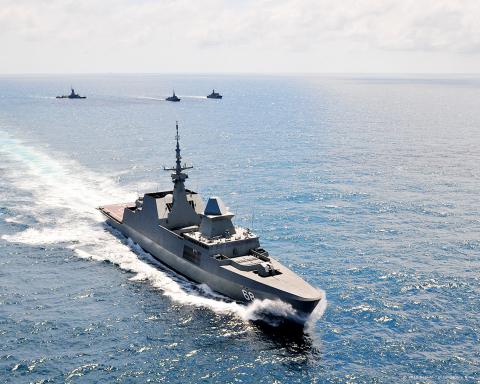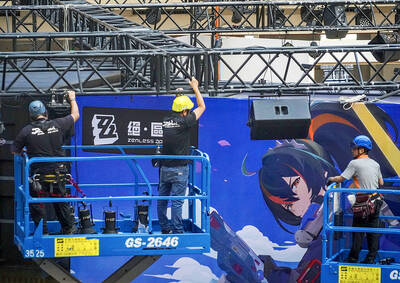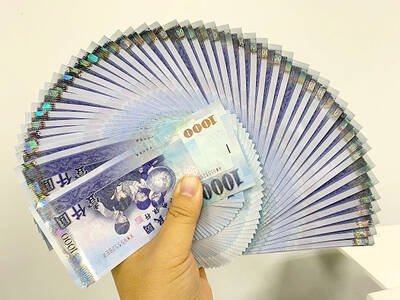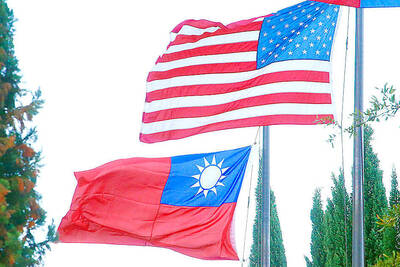The 40-year cooperation between the Republic of China Army and the Singapore Army may be at risk after the city-state sent 70 soldiers to China to an eight-day joint exercise with the People’s Liberation Army (PLA) on Sunday.
The Singaporean soldiers sent to China are from “Project Starlight,” an agreement reached between former president Chiang Kai-shek (蔣介石) and then-Singaporean prime minister Lee Kwan Yew (李光耀) in 1974 and ratified in 1975 under which Taiwan’s military helps train Singaporean troops in the so-called Starlight Exercises.
The government will closely monitor the joint exercises between the PLA and the Singaporean troops, the Ministry of National Defense said.

Screengrab from the Republic of Singapore Navy Web site
Whether the presence of the city-state’s troops at the Chinese military exercise signifies the termination of the Starlight agreement or that Singapore is changing partners from Taiwan to China remains to be seen, the ministry said.
To date, the Singaporean government has not made any changes to the pact and is continuing joint training with Taiwan, it added.
The ministry said it would try to ascertain whether the exercises with China are a one-off event, or if they represent the beginning of normalized joint military training between the two countries.
Ministry officials said that while the Singapore Army joined anti-terrorism exercises with China in 2009 and 2010, there was a significant difference between those drills and a string of recent ones.
Ministry officials said there has been a subtle shift in Singapore’s policy that has seen its army increase dialogue with its Chinese counterpart. The two sides conducted a joint military exercise in April, another in August and in September, the Singapore Army sent a company of troops to conduct joint exercises in the PLA’s Nanjing Military District, they said.
In addition to the increasing familiarity between the Singaporean and Chinese armies, the ministry said the Republic of Singapore Navy has also been reaching out to its Chinese counterpart.
According to the ministry, the Republic of Singapore Navy had sent one of its Formidable-class frigates — a derivative of the French Lafayette class — to attend an exercise with China, adding that as the Formidable-class is an upgraded Lafayette derivative equivalent to the Republic of China Navy’s Kang Ting-class, this interaction could affect future upgrades of the Taiwanese frigates.
The RSS Formidable attended a multinational naval exercise off Qingdao, China, in April, while the RSS Steadfast visited the People’s Liberation Army Navy South Sea Fleet.
The ministry said the nation’s Kang Ting-class frigates are nearing the time for crucial upgrades, which include increasing their vertical missile launch systems and replacing the MIM-72 Chaparral missiles they carry with domestically manufactured Sky Sword II missiles.
The Sky Sword II anti-aircraft missile system can be carried by platforms across all the military’s branches. The Chaparral missiles were originally made to be surface-launched anti-aircraft missiles and were developed by the US Army.
The possibility of China increasing its familiarity with Lafayette-class ships through interaction with Singapore’s Formidable-class vessels is a huge factor in determining if Taiwan’s navy will maintain its current upgrade plans or seek alternatives, the ministry said.

Taiwan is projected to lose a working-age population of about 6.67 million people in two waves of retirement in the coming years, as the nation confronts accelerating demographic decline and a shortage of younger workers to take their place, the Ministry of the Interior said. Taiwan experienced its largest baby boom between 1958 and 1966, when the population grew by 3.78 million, followed by a second surge of 2.89 million between 1976 and 1982, ministry data showed. In 2023, the first of those baby boom generations — those born in the late 1950s and early 1960s — began to enter retirement, triggering

ECONOMIC BOOST: Should the more than 23 million people eligible for the NT$10,000 handouts spend them the same way as in 2023, GDP could rise 0.5 percent, an official said Universal cash handouts of NT$10,000 (US$330) are to be disbursed late next month at the earliest — including to permanent residents and foreign residents married to Taiwanese — pending legislative approval, the Ministry of Finance said yesterday. The Executive Yuan yesterday approved the Special Act for Strengthening Economic, Social and National Security Resilience in Response to International Circumstances (因應國際情勢強化經濟社會及民生國安韌性特別條例). The NT$550 billion special budget includes NT$236 billion for the cash handouts, plus an additional NT$20 billion set aside as reserve funds, expected to be used to support industries. Handouts might begin one month after the bill is promulgated and would be completed within

NO CHANGE: The TRA makes clear that the US does not consider the status of Taiwan to have been determined by WWII-era documents, a former AIT deputy director said The American Institute in Taiwan’s (AIT) comments that World War-II era documents do not determine Taiwan’s political status accurately conveyed the US’ stance, the US Department of State said. An AIT spokesperson on Saturday said that a Chinese official mischaracterized World War II-era documents as stating that Taiwan was ceded to the China. The remarks from the US’ de facto embassy in Taiwan drew criticism from the Ma Ying-jeou Foundation, whose director said the comments put Taiwan in danger. The Chinese-language United Daily News yesterday reported that a US State Department spokesperson confirmed the AIT’s position. They added that the US would continue to

IMPORTANT BACKER: China seeks to expel US influence from the Indo-Pacific region and supplant Washington as the global leader, MAC Minister Chiu Chui-cheng said China is preparing for war to seize Taiwan, Mainland Affairs Council (MAC) Minister Chiu Chui-cheng (邱垂正) said in Washington on Friday, warning that Taiwan’s fall would trigger a regional “domino effect” endangering US security. In a speech titled “Maintaining the Peaceful and Stable Status Quo Across the Taiwan Strait is in Line with the Shared Interests of Taiwan and the United States,” Chiu said Taiwan’s strategic importance is “closely tied” to US interests. Geopolitically, Taiwan sits in a “core position” in the first island chain — an arc stretching from Japan, through Taiwan and the Philippines, to Borneo, which is shared by